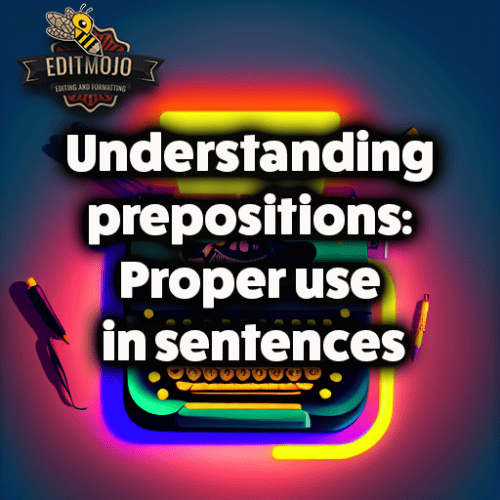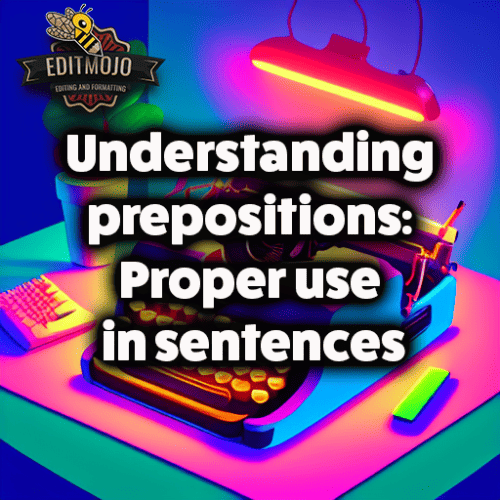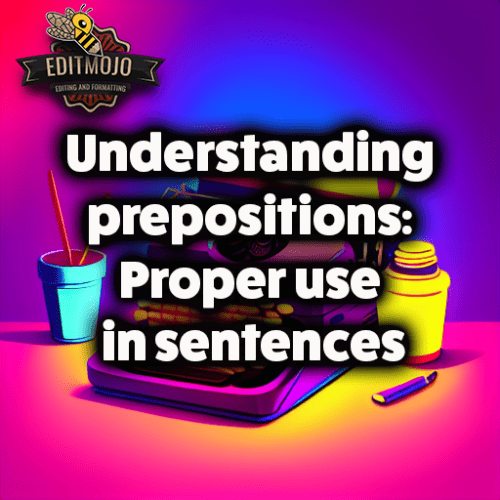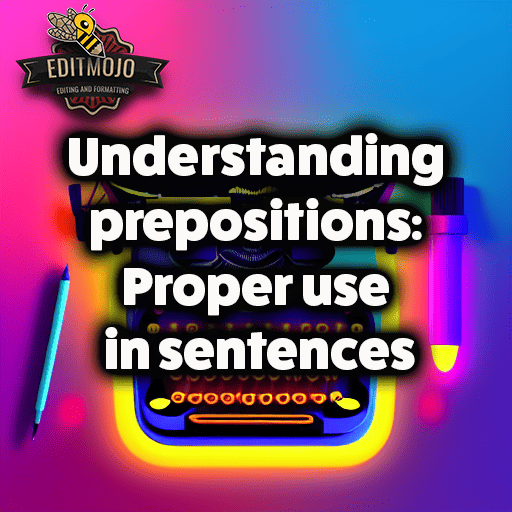Understanding prepositions: Proper use in sentences
Understanding prepositions: Proper use in sentences. Ever wondered why a small word like in, at, on, over, or with can sometimes make or break your sentences? Welcome to the world of prepositions – the tiny heroes of the English language that bind words together, providing coherence and structure to our thoughts and conversations. Whether you’re a language enthusiast, an ESL learner, or someone brushing up their grammar skills, this post will guide you through the intriguing labyrinth of prepositions. Let’s begin!
“Prepositions are not words to end sentences with.” – Winston Churchill
Key Takeaways Table (grammar)
| Key Points | Summary |
|---|---|
| Definition of Prepositions | Prepositions are words that link nouns, pronouns, or phrases to other words within a sentence. |
| Types of Prepositions | Prepositions are categorized based on their relationships: time, place, direction, manner, agent, device, and degree. |
| Common Mistakes | Misuse of prepositions often occur due to misunderstanding their functions or context. |
| Collocations | Certain combinations of words, including prepositions, frequently occur together in English. Recognizing these collocations can improve language proficiency. |
| Prepositional Phrases | These are groups of words containing a preposition, its object, and any associated adjectives or adverbs. They can function as adjectives or adverbs. |
| Misconceptions | Ending sentences with prepositions and using dangling prepositions can be grammatically acceptable, despite popular belief. |
| Formal Writing | The correct usage of prepositions is critical in formal writing contexts such as business and academic writing. |
II. Basics of Prepositions
A. What Are Prepositions?
Derived from the Latin word ‘praepositio’ which means ‘to place before’, a preposition essentially positions or orientates something else in the sentence. It introduces and connects ideas, adding richness to our language. Its basic function is to link nouns, pronouns, or phrases to other words within a sentence.

B. Types of Prepositions
Prepositions are classified according to their indicative relationships, namely: time, place, direction, manner, agent, device, and degree. Each category presents unique characteristics and usage rules, making them versatile tools in crafting sentences. Here’s a quick overview:
- Time Prepositions: used to indicate a time period (e.g., in, at, on)
- Place Prepositions: signify a place or location (e.g., at, by, under)
- Direction Prepositions: point to a direction or movement (e.g., to, into, onto)
- Manner Prepositions: describe the manner or way something is done (e.g., by, in, like)
- Agent Prepositions: illustrate a relationship between a doer and an action (e.g., by, with)
- Device Prepositions: convey the instrument used in performing an action (e.g., with, by)
- Degree Prepositions: show the level or extent of something (e.g., at, in, of)
III. Deep Dive into Each Type of Preposition
Let’s dive deeper and decode these categories with examples and common pitfalls.
A. Time Prepositions
Used to represent various aspects of time, these prepositions often accompany time-related expressions. ‘At’ is used with precise time points, ‘on’ with specific days/dates, and ‘in’ for more extended periods like months, years, seasons.
“Meet me at 5 pm.” “I was born on December 25.” “He arrived in 2022.”
However, mistakes can occur. For instance, saying “I’ll see you in Monday” is incorrect. The correct preposition is ‘on’ – “I’ll see you on Monday.”
B. Place Prepositions
These prepositions indicate the position or location of something. ‘At’ signifies a specific location, ‘in’ refers to a situation where something is enclosed, and ‘on’ describes something positioned on a surface.
“I’ll wait for you at the station.” “The keys are in the drawer.” “Your book is on the table.”
Common blunders include misusing these prepositions interchangeably. For example, saying “I’m on the library” is incorrect. The correct phrase is “I’m in the library.”

C. Direction Prepositions
They show the direction or movement of something in relation to something else. ‘To’ represents direction towards a destination, ‘onto’ signifies moving to a position on a surface, and ‘into’ implies movement resulting in being inside or enclosed.
*”I’m heading to the supermarket.”
“He jumped onto the stage.”
“She walked into the room.”*
A common mistake is to say “I’m heading in the supermarket,” which sounds as if you’re already inside and moving around in it. The correct preposition would be ‘to’.
D. Manner Prepositions
These depict how something happens or the way something is done. ‘By’ suggests the method used to achieve something, ‘in’ indicates the style or form, and ‘like’ means in the same way or similar manner.
“He won the match by playing aggressively.” “She sings in a melodious voice.” “He runs like a cheetah.”
E. Agent Prepositions
Agent prepositions connect the doer (agent) of an action to the action itself. For example, ‘by’ introduces the doer in passive sentences, and ‘with’ indicates the person or thing that uses the action.
“The cake was eaten by John.” “He cut the paper with scissors.”
F. Device Prepositions
These prepositions connect the instrument or device used to perform an action. ‘With’ and ‘by’ are most commonly used.
“I write with a pen.” “She came by car.”
G. Degree Prepositions
Degree prepositions show the level or extent of something. Common ones include ‘at’, ‘in’, and ‘of’.
“She’s good at mathematics.” “He’s interested in photography.” “The bag is full of books.”

IV. The Art of Choosing the Right Preposition
Prepositions are not standalone heroes; they work in tandem with other words, forming collocations. A collocation is a combination of words that often go together, making your English sound more fluent and natural. Understanding these will help you instinctively select the correct prepositions.
For instance, we usually say “good at something” but “interested in something”. It might not seem logical, but that’s how collocations work, and being aware of them can significantly improve your language accuracy.
V. Prepositional Phrases: Expanding Your Sentence Creativity
A prepositional phrase consists of a preposition, its object (noun, pronoun, or clause), and any associated adjectives or adverbs. A prepositional phrase can function as an adjective or adverb, providing additional details about a noun or verb.
For example, in the sentence “The cat slept on the warm, comfortable couch“, ‘on the warm, comfortable couch’ is a prepositional phrase acting as an adverb, describing where the cat slept.
VI. Misuses of Prepositions
Despite their utility, prepositions are often misunderstood and misused, even by native English speakers. Let’s dispel some common misconceptions:
A. Prepositions at the End of Sentences: Is It Always Wrong?
Contrary to popular belief, ending a sentence with a preposition is not a grammar sin. Linguist Geoffrey K. Pullum, co-author of “The Cambridge Grammar of the English Language,” defends this practice, asserting that it often makes sentences sound more natural.
B. Redundant Prepositions
Avoid using unnecessary prepositions. For example, instead of saying, “Where are you at?” you can simply ask, “Where are you?” The meaning remains clear without the added preposition.
C. Dangling Prepositions
Dangling prepositions occur when a sentence ends with a preposition that doesn’t
have an object. While considered less formal, it’s acceptable in spoken English or informal writing. For example, “What did you put that there for?”
VII. Mastering Prepositions in Formal Writing
Choosing the correct preposition becomes particularly crucial in formal writing like business or academic writing. Misused prepositions can tarnish your professional image and make your writing difficult to understand.
VIII. Fun Facts and Trivia About Prepositions
Did you know that prepositions also feature in various popular idioms and phrases, such as ‘at a loss’, ‘in a nutshell’, and ‘on cloud nine’? Also, some renowned authors have flouted traditional rules by starting their sentences with prepositions. Consider Jane Austen’s famous opening line in Pride and Prejudice: “It is a truth universally acknowledged that a single man in possession of a good fortune must be in want of a wife.”
IX. Quizzes and Practice Exercises
Why not test your understanding of prepositions through online quizzes and exercises? Practice makes perfect, and these resources offer valuable insights into your mastery of prepositions.
X. Conclusion (Understanding prepositions: Proper use in sentences)
We’ve journeyed through the landscape of prepositions, shedding light on their importance, versatility, and complexities. Armed with this knowledge, you can now forge ahead, crafting sentences that are grammatically sound and stylistically elegant. Remember, language is an art, and prepositions are the subtle strokes that add depth and detail to your linguistic canvas. Continue practicing, keep learning, and enjoy the process of mastering prepositions in the English language! Questions or comments? Feel free to share below.
Sure, here you go!
Top Five Questions and Answers Table (Understanding prepositions: Proper use in sentences)
| Questions | Answers |
|---|---|
| What is a preposition? | A preposition is a word that links nouns, pronouns, or phrases to other words within a sentence. |
| What are some examples of prepositions? | Examples of prepositions include in, at, on, over, under, by, and with. |
| Can a sentence end with a preposition? | Contrary to popular belief, it is not grammatically incorrect to end a sentence with a preposition. |
| What are collocations? | Collocations are combinations of words that often go together in English, helping the language sound more fluent and natural. |
| What is a prepositional phrase? | A prepositional phrase consists of a preposition, its object (noun, pronoun, or clause), and any associated adjectives or adverbs. It can function as an adjective or adverb in a sentence. |
